“Conversations with Cloth: Kikai-Sekka Shibori, Arimatsu to Africa with Ana Lisa Hedstrom and Yoshiko Wada” by Eva-Maria Spampinato
January 20, 2021
Exporting Shibori from Arimatsu to Africa, Machine Sewn-Resist and Complex Substrate (Episode 4), was the final episode of Slow Fiber Studios’ online talk Conversations with Cloth. Hosts Yoshiko Iwamoto Wada and Ana Lisa Hedstrom ended the premier series on how Arimatsu artisans created new textile designs when faced with foreign trade opportunities, post WWII. Highlighting upon two key points, how global trade is a persistent catalyst for innovations and how artisans and artists are adaptable when met with new challenges and limitations that give birth to more possibilities.
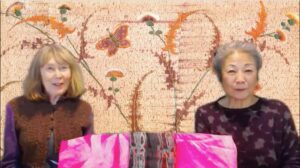
Episode 4: Exporting Shibori from Arimatsu to Africa, Machine Sewn-Resist and Complex Substrate: Ana Lisa Hedstrom and Yoshiko Iwamoto Wada, 2021.
To produce bold designs on broadcloth efficiently for the African market (1934-37 and 1945-1950), the Arimatsu artisans created a new shibori technique called kikai-sekka, a compression-resist using a sewing machine on broadcloth or glossy cloth for a popular market. To better understand this under-researched historical period, with limited historical records, Yoshiko and Ana Lisa focused on, how Arimatsu artisans legitimized the sewing machine as an extension of hand-tools and created innovative designs by adding complexity with prints, wovens, and textures with shibori hand craft. The episode features ingenious 21st century masters of medium and contemporary adaptations by artists & designers.
History
In 1935-37, Garber Trading Company in Kobe, initiated to export with the Arimatsu Shibori Corporation textiles to South Africa sarongs for the muslim population. The export business discontinued due to cotton shortage and unfavorable currency exchange rate due to WW2. Generating about 520,445 yards at about current value of 139,903 JPY.
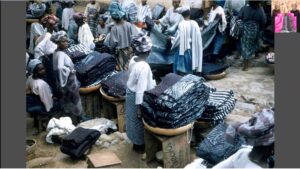
Episode 4: Exporting Shibori from Arimatsu to Africa, Machine Sewn-Resist and Complex Substrate: discussing African markets, image from Garber Trading Company archive.
In 1945, a second attempt under post-war devastation, inflation, lack of raw materials, shibori merchants began to re-establish production infrastructure. In 1948, Garber initiated an export business to Belgium Congo. Garber identified local interest in broadcloth, shiny blue cloths, bright red, green, yellow and various design trends. Between 1948-1950, a 11 month exporting period of blue and white cloth 365,504 yards, chusen print shibori (new katazome, dye-paste stencil printing) 533,115 yards and coloured shibori 24,003 yards. Totaling 922,622 yard, valued at 180,000 JPY. After 1950, despite the fact the exchange rate was set at 1 USA=360 JPY that is unfavorable to certain African countries, there are some textiles exported into the 1950s.
Crazy & Wild Designs
The artisans were challenged to appeal to an entirely different market, shibori artisans went beyond their cultural idioms and prefered colors, they have displayed what we may describe as “crazy” or “wild” images, colors, and compensation. We wonder “where did it come from?”
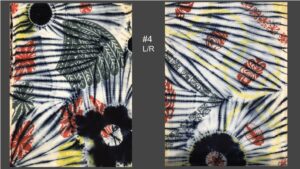
Episode 4: Exporting Shibori from Arimatsu to Africa, Machine Sewn-Resist and Complex Substrate: Pop quiz Arimatsu African Shibori on printed textiles.
21st Century Masters of Medium
Ana Lisa Hedstrom: Ana Lisa has devoted 45 years exploring all aspects of traditional shibori processes beyond what Japanese master artisans have accomplished. Her ingenious and perceptive way of having a dialogue with materials and processes articulates designs within contemporary artistic oeuvre.
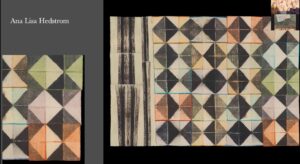
Episode 4: Exporting Shibori from Arimatsu to Africa, Machine Sewn-Resist and Complex Substrate: Ana Lisa Hedstrom Quilt Katano, machine sewn-resist, dye, fiber.
Catharine Ellis: master of weaving and natural dyes. Catharine’s work brilliantly interconnects her fiber and dye knowledge into creating unique expressions using complex substrates: jacquard weaving of checkered or strips by joining cellulose and protein fibers (wool and cotton/silk). Her latest discovery was applying itajime shibori after woven shibori cloth is all compressed and dyed. Resulting design was extended as the shibori was unraveled into a large diamond shape in the middle.
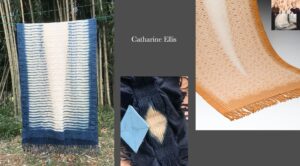
Episode 4: Exporting Shibori from Arimatsu to Africa, Machine Sewn-Resist and Complex Substrate: Catharine Ellis, gathered woven shibori cloth, itajime shibori, natural dye.
Jean Cacicedo: called ‘Queen of Shrink’, Jean’s artwork constantly pushes fulling fiber into 3D surface, by manipulating the fiber after wool is sewn onto non-shrink fabric and thrown into a washing to fully it tightly, you will find puckered, 3-D forms over fulled/felted surface of wool fabric. (Fulling wool sold at Slow Fiber Studios).
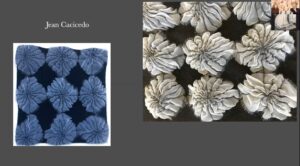
Episode 4: Exporting Shibori from Arimatsu to Africa, Machine Sewn-Resist and Complex Substrate: Jean Cacicedo, machine sewn-resist, washing machine, organza, fulling wool.
21st Century Contemporary Adaptations
Yoshiko elaborates how the use of the machine sewn-resist shibori is still not widely or extensively explored, though here a few artists and designers practice this technique.
Neha Puri Dhri: foremost exponent of the machine sewn-resist to one of the highest levels of artistic creative work in Fine Art. She is represented by Browngrotta Gallery.
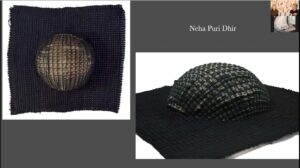
Episode 4: Exporting Shibori from Arimatsu to Africa, Machine Sewn-Resist and Complex Substrate: silk, fiber.
Kim Eichler-Messmer: artist. Kim’s quilts are a surface design of her own kind of language using the machine sewn-resist and dyes. She has mastered very complex geometries and a systematic process of folds and dyeing approaches that bring a deep range of colors, hues and design.
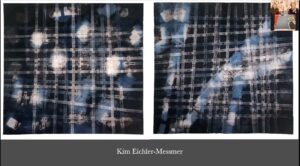
Episode 4: Exporting Shibori from Arimatsu to Africa, Machine Sewn-Resist and Complex Substrate: Kim Eichler-Messmer, machine sewn-resist, dyeing.
Yoshiko touches upon how Indian designers have been incorporating machine sewn-resist. She notes two designers: Amrit Das, Indian couture ladies fashion designer, and Manoji at SML Designs worked for the former Haveli of Proomima Jain in Delhi that was the earliest couture design house to use machine sewn-resist.
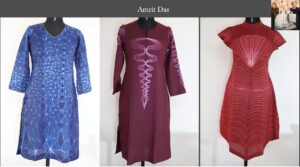
Episode 4: Exporting Shibori from Arimatsu to Africa, Machine Sewn-Resist and Complex Substrate: Amrit Das, machine Sewn-resist, various fibers.
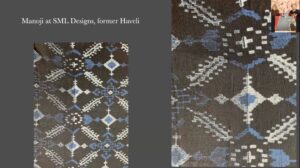
Episode 4: Exporting Shibori from Arimatsu to Africa, Machine Sewn-Resist and Complex Substrate: Manoji, machine sewn-resist, unknown materials.
-Eva-Maria Spampinato
Conversations with Cloth Series TWO will connect global shibori traditions in Africa, South America, and India with Japan. Starting February through May, every third Wednesday of the month. We will also offer online hands-on workshops by master artisans who will work closely with Yoshiko and Ana Lisa to develop cultural historical context. For access to Series ONE, all four episodes visit Slow Fiber Studios. The archival streaming editions of the will a collection of documented oral histories, ideal for inspiration, educators, scholars of craft, design, textile, and art.
Other artists and designers discussed are: Jane Callender, Marie-Helene Guelton.
